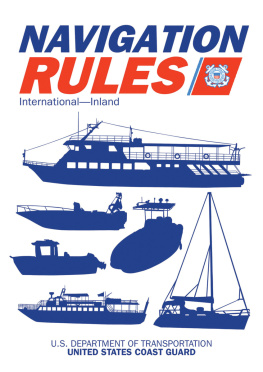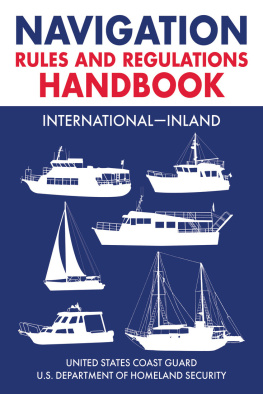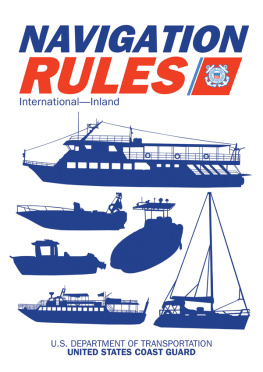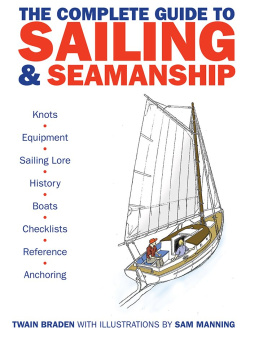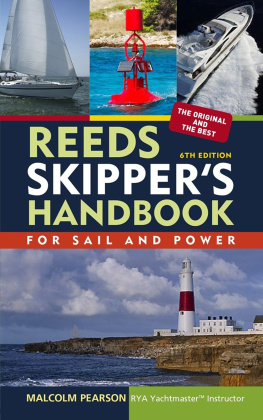First published by the U.S. Coast Guard 2015.
First Skyhorse edition 2018. No copyright claimed.
Skyhorse Publishing books may be purchased in bulk at special discounts for sales promotion, corporate gifts, fund-raising, or educational purposes. Special editions can also be created to specifications. For details, contact the Special Sales Department, Skyhorse Publishing, 307 West 36th Street, 11th Floor, New York, NY 10018 or .
Skyhorse and Skyhorse Publishing are registered trademarks of Skyhorse Publishing, Inc., a Delaware corporation.
Visit our website at www.skyhorsepublishing.com.
10 9 8 7 6 5 4 3 2 1
Library of Congress Cataloging-in-Publication Data is available on file.
Cover design by U.S. Coast Guard
ISBN: 978-1-6160-8243-7
Ebook ISBN: 978-1-5107-3518-7
Printed in the United States of America

CONTENTS
________________
Footnotes proceeded by the double-dagger () symbol indicates clarifications added by the U.S. Coast Guard Office of Navigation Systems; and, are not found in the original source material.
INTRODUCTION
International Rules
The International Rules in this book were formalized in the Convention on the International Regulations for Preventing Collisions at Sea, 1972, and became effective on July 15, 1977. The Rules (commonly called 72 COLREGS) are part of the Convention, and vessels flying the flags of states ratifying the treaty are bound to the Rules. The United States has ratified this treaty and all United States flag vessels must adhere to these Rules where applicable. President Gerald R. Ford proclaimed 72 COLREGS and the Congress adopted them as the International Navigational Rules Act of 1977.
The 72 COLREGS were developed by the Inter-Governmental Maritime Consultative Organization (IMCO) which in May 1982 was renamed the International Maritime Organization (IMO). In November 1981, IMOs Assembly adopted 55 amendments to the 72 COLREGS which became effective on June 16, 1983. The IMO also adopted 9 more amendments which became effective on June 29, 1989. A single amendment became effective March 19, 1991. In 1993 8 amendments were adopted by the IMO which entered into force in 1995. The IMO adopted 9 amendments which entered into force November 29, 2003. Lastly, a single amendment was adopted which updated the Distress signals and entered into force on December 1, 2009. The International Rules in this book contain these amendments.
These Rules are applicable on waters outside of established navigational lines of demarcation. The lines are called COLREGS Demarcation Lines and delineate those waters upon which mariners shall comply with the Inland and International Rules. COLREGS Demarcation Lines are contained in this book.
INTRODUCTION
Inland Regulations
The Inland Rules in this book replace the old Inland Rules, Western Rivers Rules, Great Lakes Rules, their respective pilot rules and interpretive rules, and parts of the Motorboat Act of 1940. Many of the old navigation rules were originally enacted in the 1800s. Occasionally, provisions were added to cope with the increasing complexities of water transportation. Eventually, the navigation rules for United States inland waterways became such a confusing patchwork of requirements that in the 1960s several attempts were made to revise and simplify them. These attempts were not successful.
Following the signing of the Convention on the International Regulations for Preventing Collisions at Sea, 1972, a new effort was made to unify and update the various inland navigation rules. This effort culminated in the enactment of the Inland Navigational Rules Act of 1980. This legislation sets out Rules 1 through 38 - the main body of the Rules. The five Annexes were published as regulations. It is important to note that with the exception of Annex V to the Inland Rules, the International and Inland Rules and Annexes are very similar in both content and format.
The effective date for the Inland Navigation Rules was December 24, 1981, except for the Great Lakes where the effective date was March 1, 1983.
On May 17, 2010 the US Coast Guard published a Final Rule which placed the Inland Navigational Rules into the Code of Federal Regulations. This move was in accordance with the Coast Guard and Maritime Transportation Act of 2004, which repealed the Inland Navigation Rules as they appeared in United States Code.
This Handbook supersedes Commandant Instruction M16672.2D, Navigation Rules: InternationalInland. It maintains the same format and provides additional and updated content. Not all U.S. Navigation Regulations found in Title 33 of the Code of Federal Regulations are contained in this handbook.
LEGAL CITATIONS
72 COLREGS
| International Navigational Rules | Public Law 95-75; |
| Act of 1977 | 91 Stat 308; |
| 33 U.S.C. 1601-1608 |
| COLREGS Demarcation Lines | 33 CFR 80 |
| 72 COLREGS: Implementing Rules | 33 CFR 81 |
| 72 COLREGS: Interpretative Rules | 33 CFR 82 |
| Amendments to 72 COLREGS Effective June 1, 1983 | 48 FR 28634 |
| COLREGS Penalty Provisions | 33 U.S.C. 1608 |
| INLAND RULES |
| Inland Navigational Rules Act of 1980 | Public Law 96-591; |
| 94 Stat 3415; |
| 33 CFR 83 |
| Annex I: Positioning and Technical Details of Lights and Shapes | 33 CFR 84 |
| Annex II: Additional Signals for Fishing in Close Proximity | 33 CFR 85 |
| Annex III: Technical Details of Sound Signal Appliances | 33 CFR 86 |
| Annex IV: Distress Signals | 33 CFR 87 |
| Annex V: Pilot Rules | 33 CFR 88 |
| Inland Navigation Rules: Implementing Rules | 33 CFR 89 |
| Inland Navigation Rules: Interpretative Rules | 33 CFR 90 |
| Boundary Lines | 46 CFR 7 |
| Inland Rules Penalty Provisions | 33 U.S.C. 2072 |
| VESSEL NAVIGATON REGULATIONS |
| Vessel Bridge-to-Bridge Radiotelephone Act | Public Law 92-63; |
| 85 Stat.164; |
| 33 U.S.C. 1201-1208 |
| Vessel Bridge-to-Bridge Radiotelephone Regulations | 33 CFR 26 |
| Other FCC Regulations Pertaining to Maritime Communications | 47 CFR 80.1001-80.1023 |
| Vessel Traffic Management | 33 CFR 161 |
| OPERATIONS OF VESSELS GENERALLY |
| Penalties for Negligent Operations | 33 U.S.C. 2302 |
| Duties Related to Marine Casualty | 33 U.S.C. 2303 |
| Duty to Provide Assistance at Sea | 33 U.S.C. 2304 |
| Vessel Reporting Requirements | 33 U.S.C. 2306 |
CONVERSION TABLE
Conversion of Metric to U.S. Customary/Imperial Units
| Metric Measure | U.S. Customary/Imperial Measure (approximately) |
| 1,000 Meters (M) | 3,280.8 ft. |
| 500 M | 1,640.4 ft. |
| 200 M | 656.2 ft. |
| 150 M | 492.1 ft. |
| 100 M | 328.1 ft. |
| .. 75 M | 246.1 ft. |
| .. 60 M | 196.8 ft. |
| .. 50 M | 164.0 ft. |
| .. 25 M | 82.0 ft. |
| .. 20 M | 65.6 ft. |
| .. 12 M |

